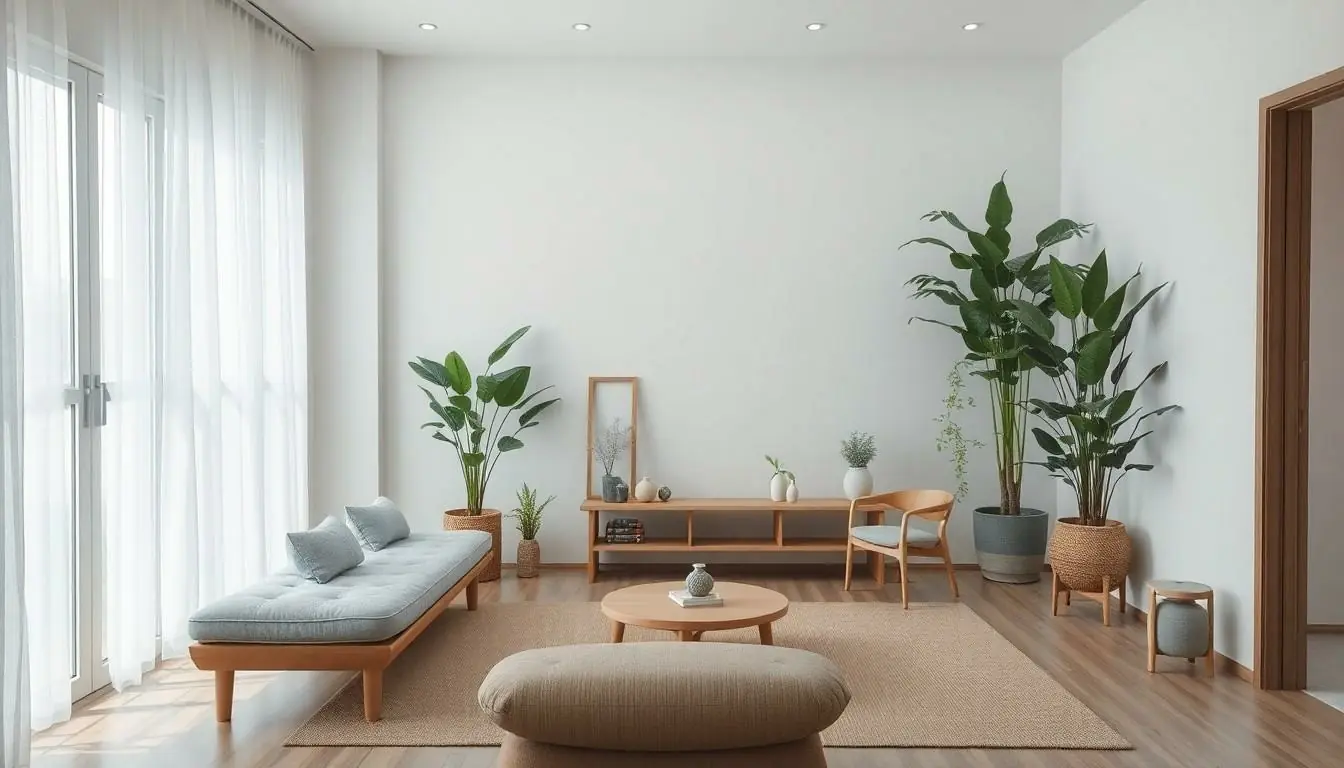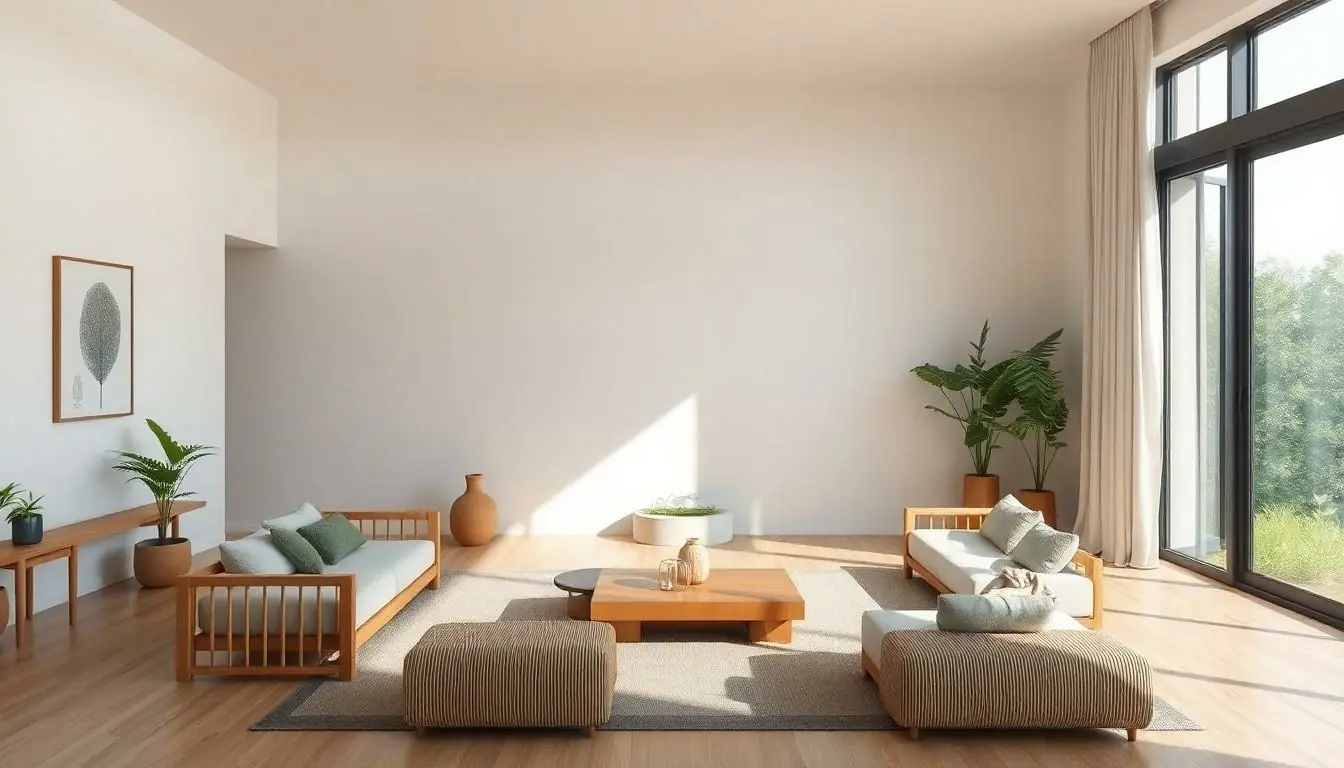In a world buzzing with chaos and clutter, finding tranquility at home feels like searching for a needle in a haystack. Enter zen interior design, the ultimate sanctuary for those craving calm amidst the storm. Imagine stepping into a space that whispers serenity, where every corner invites relaxation and creativity flows like a gentle stream.
Zen design isn’t just about aesthetics; it’s a lifestyle choice that transforms homes into havens. With its clean lines, natural materials, and harmonious colors, this approach creates an atmosphere that makes stress feel like a distant memory. So why not trade that chaotic living room for a serene oasis? Your inner peace is just a few design choices away, and who wouldn’t want to sip tea in a space that feels like a warm hug?
Table of Contents
ToggleWhat Is Zen Interior Design?
Zen interior design centers on simplicity and tranquility. This design philosophy emphasizes minimalism, focusing on clean lines and uncluttered spaces. It draws inspiration from traditional Japanese aesthetics, aiming to create calm environments that promote peace and meditation.
Natural materials play a crucial role in zen design. Wood, stone, and bamboo enhance the connection between indoor spaces and nature. Using these materials fosters a sense of warmth and grounding, essential for achieving a serene atmosphere.
Color palettes in zen interior design prioritize soft, neutral tones. Shades such as beige, gray, and white enhance light and space without overwhelming the senses. These gentle hues create a harmonious backdrop, further contributing to relaxation.
Furniture in zen spaces usually features simple forms. Low-profile pieces, such as low tables and floor cushions, enhance a sense of openness. Arranging furniture thoughtfully encourages flow and movement, promoting a tranquil living environment.
Decorative elements are intentionally sparse in zen interior design. Focusing on a few meaningful items enhances their significance, rather than creating visual clutter. Plants, art, or handcrafted items can serve as focal points, bringing nature and personality into the space.
Incorporating water features offers an additional layer of tranquility. Elements like small fountains or aquariums introduce soothing sounds and promote mindfulness. Overall, zen interior design serves as a pathway to a more harmonious lifestyle, creating peaceful havens amid daily chaos.
Key Principles of Zen Interior Design

Zen interior design emphasizes key principles that create a tranquil environment. Minimalism, natural elements, and calm color palettes play a significant role in achieving this serene aesthetic.
Minimalism
Minimalism focuses on simplicity and decluttering spaces. Each piece of furniture serves a purpose, enhancing usability without overwhelming the room. Consider low-profile furniture that encourages open areas and flow. Spaces promote clarity by limiting decorative items to those with personal significance. Adopting a “less is more” mindset ensures every element contributes to the overall calmness of the environment.
Natural Elements
Natural elements establish a connection between the indoors and nature. Wood, stone, and bamboo serve as primary materials, bringing warmth and grounding to the space. Incorporating plants adds life and vibrancy while improving air quality. Water features, such as small fountains, introduce soothing sounds and inspire mindfulness. Prioritizing these elements enhances the overall tranquility and promotes relaxation.
Calm Color Palettes
Calm color palettes create a serene backdrop for any room. Soft, neutral tones like beige, gray, and white promote relaxation and create a cohesive look. These colors enhance natural light, contributing to a brighter atmosphere. Incorporating subtle variations in texture adds dimension without disrupting harmony. Prioritizing calm colors contributes significantly to a peaceful and inviting space, aligning with the essence of zen interior design.
Benefits of Zen Interior Design
Zen interior design offers numerous advantages for creating a calm and restorative environment. By emphasizing simplicity and natural elements, this approach fosters a unique sense of tranquility.
Enhanced Serenity
Serenity flourishes in Zen-designed spaces. Clutter-free environments minimize distractions, allowing individuals to experience peace in their homes. Natural materials like wood and stone instill warmth and grounding, further enhancing relaxation. Incorporating soft, neutral colors contributes to a soothing atmosphere, inviting individuals to unwind. Water features, such as small fountains, create soundscapes that promote mindfulness. By prioritizing these elements, Zen interiors cultivate spaces that support emotional well-being and mental clarity.
Improved Focus
Focus improves significantly in Zen-inspired environments. Simplified, clean lines eliminate visual noise, allowing the mind to concentrate better. Each piece of furniture serves a distinct purpose, ensuring functionality and reducing chaos. Natural light, enhanced by strategic color choices, creates a stimulating atmosphere conducive to productivity. Adding plants contributes to improved air quality and provides a refreshing visual appeal. Cultivating these aspects leads to increased mental clarity, helping individuals engage more effectively with tasks and foster creativity.
How to Implement Zen Interior Design in Your Space
Zen interior design transforms living areas into peaceful retreats. Follow these guidelines to create a serene atmosphere.
Selecting the Right Furniture
Choose furniture that emphasizes simplicity and functionality. Opt for low-profile pieces made from natural materials like wood and bamboo. Select items that serve a purpose without overwhelming the space. Prioritize comfort by incorporating soft seating and minimalistic designs. Avoid heavy, ornate furniture that disrupts the tranquil vibe. Organizing furniture to promote flow enhances the sense of openness.
Incorporating Nature
Integrate natural elements to enhance the connection between indoor and outdoor spaces. Consider using plants like bamboo, succulents, or ferns for their calming effects. Add wooden accents or stone features to foster visual warmth. Water elements, like small fountains, introduce soothing sounds that promote relaxation. Using organic shapes found in nature softens hard lines and complements other design elements.
Creating Open Spaces
Maintain open spaces to promote a sense of calm and serenity. Arranging furniture to facilitate easy movement creates a more inviting atmosphere. Limit decorative items to keep areas uncluttered and airy. Utilize natural light by keeping window treatments minimal, allowing sunlight to fill the space. Encourage simplicity by choosing fewer, impactful pieces that elevate the area without overwhelming. An uncluttered environment facilitates mental clarity, essential in zen design.
Embracing zen interior design can significantly enhance the quality of life by transforming spaces into tranquil retreats. This approach not only promotes relaxation but also encourages creativity and mental clarity. By prioritizing simplicity and natural elements, individuals can create environments that foster emotional well-being.
The principles of zen design serve as a guide for cultivating a peaceful atmosphere amid daily chaos. Implementing these strategies allows for a deeper connection to one’s surroundings, ultimately leading to a more harmonious lifestyle. Adopting zen interior design is more than just an aesthetic choice; it’s a commitment to nurturing a serene and mindful home.




